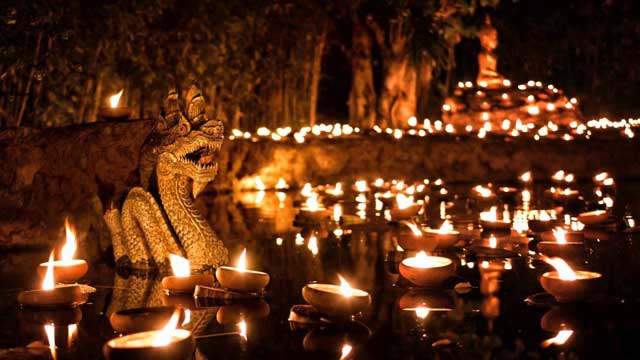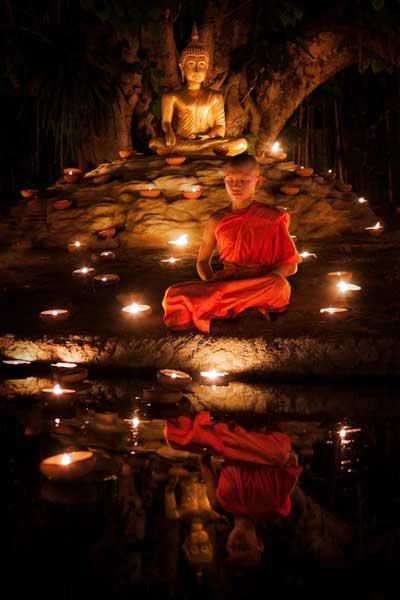When I first launched my photography career, I started with fine art photography, selling prints of photos I took at home. Eventually, I combined this passion with my love of travel and got more into travel photography.
Nowadays, my photo sales are split between stock and fine art prints. But one image that has always been one of my best sellers is this photo of a young monk meditating in Thailand:
Here’s the story behind the photo:
When I lived in Thailand many years ago, I used to dine out often. One evening I heard a local talking about an approaching Buddhist holiday called Makha Bucha Day. Unlike the famous Floating Lantern Festival, this event was less popular among foreigners.
The conversation got me curious, and I started asking around for more information, since I wanted to photograph cultural events to improve my portfolio.
Not far from where I lived was a temple with a small pond built specifically for the ceremony. I grabbed my camera and walked around to get familiar with the area.
On the day of the festival, since I had done my homework, I arrived at the temple earlier than the crowd, chose my spot, and waited. I knew that the ceremony was going to be held at nighttime and involved candles, so I brought my tripod to shoot in low light conditions. The place filled up very quickly, but I was already in the front row with a clear view of the pond.
Once the festival started, young monks lit up the place with hundreds of candles. They then sat down to meditate while the head monk chanted prayers in the background. I adjusted my angle to capture the reflections in the pond and create a “Zen” photo:
That is where I was able to get my best selling shot of the young boy peacefully meditating. This photo regularly sells as large fine art prints and smaller posters and postcards on my website.
The overall experience was incredible, but I wouldn’t have been able to capture it without prior research.
Here are a few takeaways from this experience that helped me capture more saleable photos:
1. Do your research
As a photographer, it’s important to be aware of the events that happen in your area. I recommend asking around, browsing older publications, or using the Internet to research what’s coming up to keep your calendar updated.
Plus, you don’t need to travel to exotic destinations! Even the smallest towns have regular events, and local newspapers might be interested in getting a few photos from it.
2. Scout the area
Before the start of an event, get into the habit of scouting the area and picking the best spots in advance. Become familiar with the layout. Knowing where to be to get the best angles before the crowd arrives is important and will allow you to get the best photos with an unobstructed view.
3. Take as many photos as you can
Digital photography is free, so take as many photos as you can from different angles and perspectives. Zoom in, zoom out, move around your subject, and look behind.
Try to find a story to tell which will make the image more interesting. The more photos you take, the higher the chance there is a saleable shot in the mix. I took multiple photos of the event that sold as editorial and commercial stock, fine art, and even got me my first contract with Great Escape Publishing!
4. Pick your platform
Since you’ll end up with hundreds of photos of the event, go through them and pick only the strongest ones to add to your portfolio.
Ask yourself which photos would sell best as commercial stock, editorial, or fine art. For example, if you don’t have model releases, then your photos should be uploaded as editorial stock or fine art.
If some photos aren’t selling well, don’t hesitate to move them around. Some of my monk photos were originally uploaded as editorial stock, but after noticing the low number of sales, I uploaded them on fine art websites where they found better success. However, make sure you don’t upload the same photo on both stock and fine art websites. This might upset your clients and lead to bad publicity.




